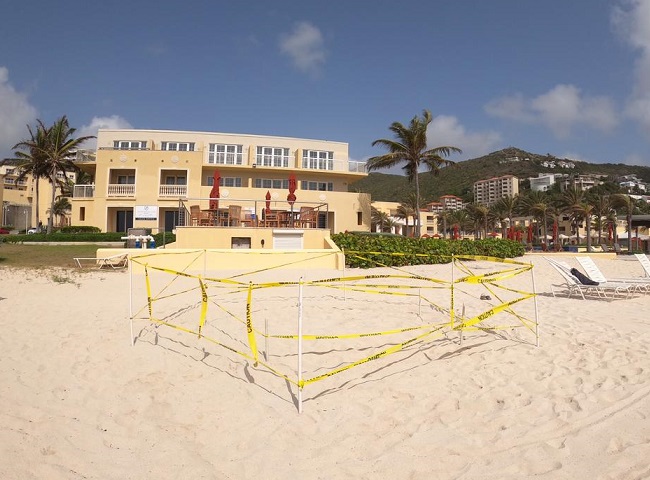PHILIPSBURG, Sint Maarten — Last week the Nature Foundation confirmed the successful nesting of a hawksbill sea turtle on Dawn Beach. After receiving a call from the security team from the Westin Hotel, foundation staff rushed to the scene and were able to confirm the hawksbill sea turtle laid several eggs in a shallow nest. While this is not the first sea turtle nesting activity on St. Maarten this year, it is the first that has been confirmed to be successfully laid on the Dutch side beaches for the season
“We were very happy to see that this hawkbill sea turtle has been able to lay at least one clutch of eggs on Dawn Beach last week, as nesting numbers are dropping. We are very grateful that the security of the Westin Hotel was very cooperative and reached out to us quickly, in order for us to monitor the nesting activity and to ensure it remains safe until the eggs are ready to hatch. Sea turtles are a protected and critically endangered species, monitoring their nesting activity is crucial and the Nature Foundation is the designated authority to report any sea turtle nesting activity to” explained Melanie Meijer zu Schlochtern Manager of the Nature Foundation St. Maarten.
Foundation staff clearly marked the nest to ensure that it can remain undisturbed. All beach visitors are requested to stay out of the marked area to prevent damages to the eggs. Sea turtles and their nests are protected by St. Maarten law and disturbing them may result in prosecution. Eggs can be laid in a shallow nest and close to the surface of the sand. It is essential to prohibit any beach umbrellas being placed in the area which may pierce the eggs, prevent walking over the eggs, and to ensure that there is absolutely no chance of the nest being driven over by any type of vehicle.
Hawksbill sea turtles nest every one to five years, coming ashore up to five times and lay a maximum of 160 eggs. Unfortunately, even with the large number of eggs that are laid sea turtles only have a 1% chance of living to adulthood. “Those visiting Dawn Beach should stay clear of the marked area to give the highest chance of survival to these eggs” confirmed the Nature Foundation.
The day before this nest was confirmed, video footage was sent to the Nature Foundation of a hawksbill sea turtle coming ashore on Indigo Bay a very short distance and then returning to the sea after showing signs of being disturbed. The reason a sea turtle would come ashore in St. Maarten is to nest, sea turtle nesting season lasts at least from April to November each year. In the video you can see the sea turtle coming ashore in the late afternoon and several beach visitors are in the area. The proximity of the spectators is a major deterrent for nesting sea turtles and a very likely cause of its choice to return to the sea.
“While it is an amazing event to witness a sea turtle coming ashore to nest, it is essential that more space is given to ensure that they can successfully lay their eggs. While it was obviously not the intention of those in the area to discourage the efforts of the hawksbill at Indigo Bay, following our sea turtle nesting guidelines will help promote more positive nesting activity in the future,” explained the Nature Foundation St. Maarten.
Sea Turtle Nesting Activity Guidelines:
- Contact the Nature Foundation right away if you see or suspect sea turtle nesting activity
- Always maintain a minimum of 30 meters distance from sea turtles that come ashore and reduce noise. Ensure others and children in the area do the same
- Never use flashlights or flash photography as sea turtles are very sensitive to lights and will even avoid nesting entirely on well-lit beaches
- Do not allow dogs or other animals to approach the sea turtle
- Do not allow any type of vehicle to drive on sea turtle nesting beach during the nesting season.
Remember sea turtles are a protected species on SXM and it is illegal to kill, wound, capture or pick up sea turtles. It is also illegal to directly or indirectly disturb their environment resulting in a physical threat or damage, or to commit other acts which result in disturbance of the animal. It is forbidden to disturb, damage or destroy sea turtle nests, lairs or breeding places. In addition, it is forbidden to pick up or to destroy the eggs of any species of sea turtle.






























